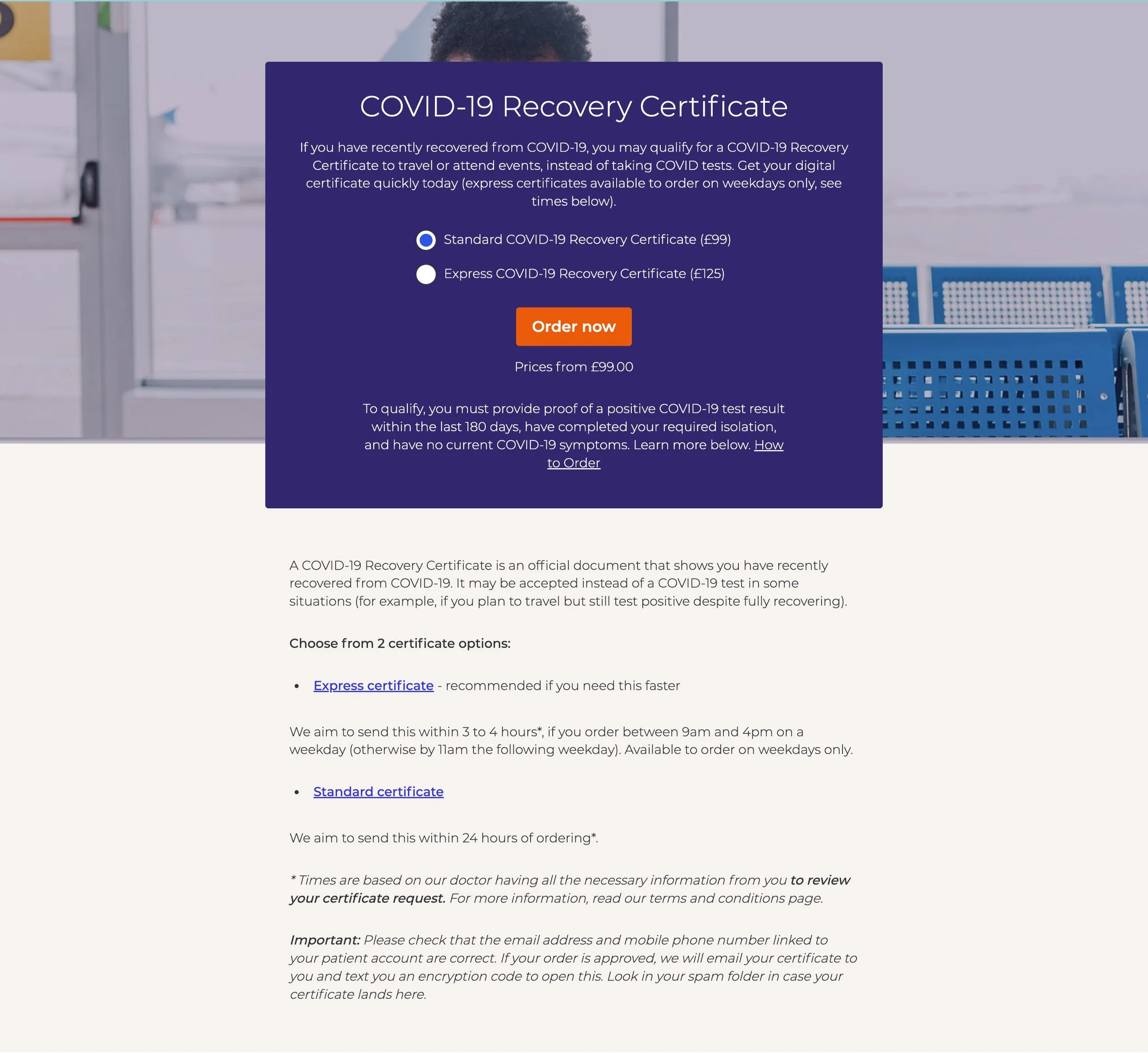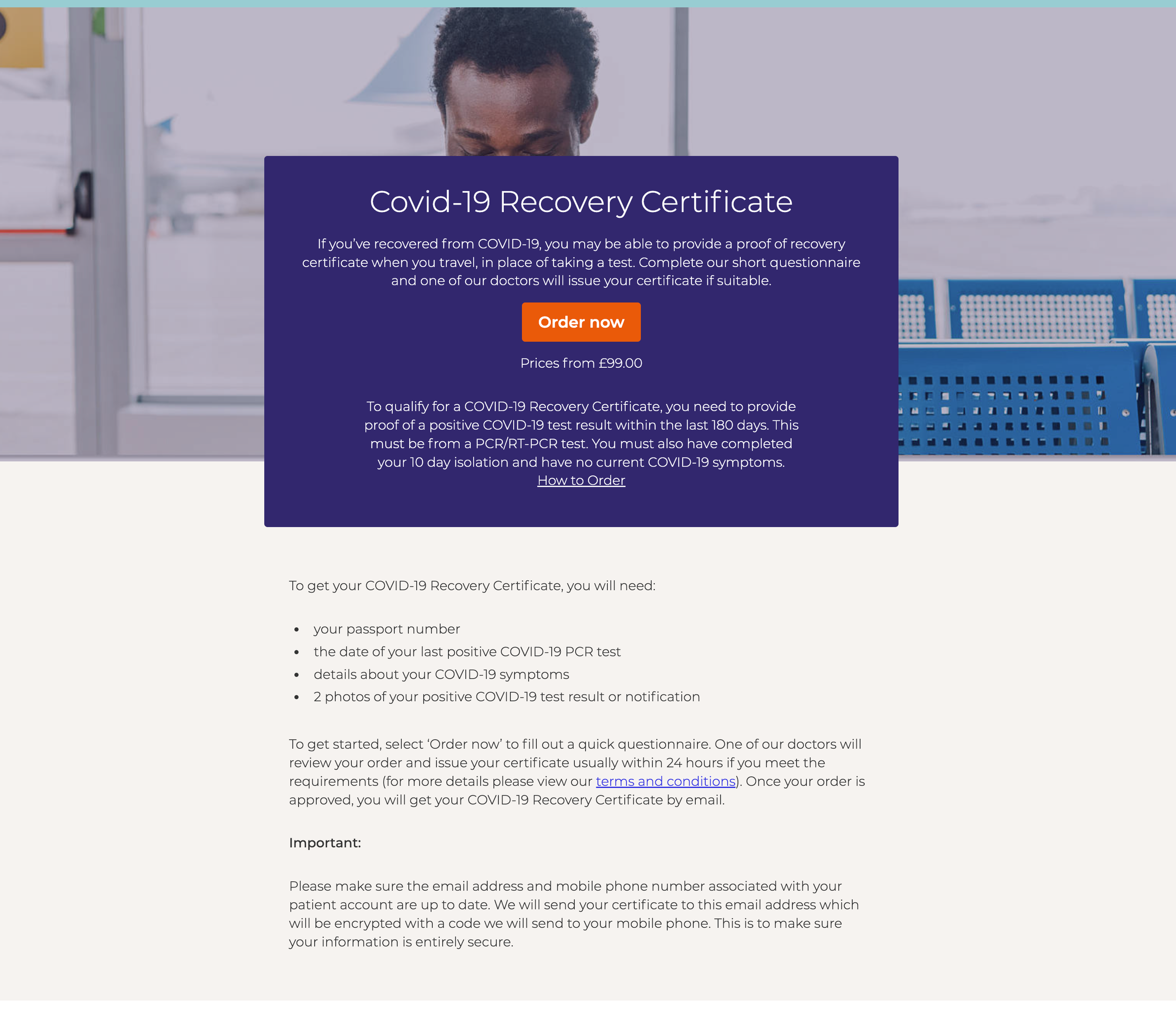COVID certificate page
ZAVA
Introduction
ZAVA is an asynchronous online service that lets users request a COVID recovery certificate online. The certificate can be used to prove users have recently recovered from a COVID-19 infection and pose no risk of infection in order to fly abroad, attend events etc.
To request a certificate, users must complete an online ‘consultation’ which they can enter from the service page. The Clinical team then reviews their information including evidence of their positive result before issuing their certificate if suitable.
The problem
In January 2022, recovery certificates were becoming a widely accepted option to meet COVID-19 requirements for those who had recently recovered from an infection - especially those still testing positive but not infectious.
The recovery certificate service was quickly launched around this time to capitalise on demand.
After several weeks, clickthrough to the consultation was lower than expected compared to other COVID services. This was despite the service page seeing good organic traffic. Exit rate was also high.
Read more about the problem and what I learned, below (‘Actions’).
Why this service?
The Commercial team highlighted this as a high average order value (AOV) service. Search traffic for recovery certificates had grown steadily around this time too.
Hypothesis
By optimising the page to better meet users’ needs, entry rate into the consultation will improve.
Actions
My initial hunch was that the content at the top of the page didn’t work hard enough to explain:
what a recovery certificate was
why or when users should get a recovery certificate instead of taking a test
Instead of promoting the benefits of recovery certificates, we were using this valuable digital real estate to talk about what was needed to apply and how our doctors processed requests. Google Analytics and Hotjar told us that the majority of users saw this content before gradually dropping off and exiting the page.
I wasn’t very familiar with recovery certificates and I had a feeling that our audience felt the same way. PCR and lateral flow tests were still the predominant method of checking a person’s COVID-19 status.
I wanted to learn more about users’ needs when it came to getting a COVID recovery certificate to confirm this hunch.
This involved:
reviewing user journeys to/from the current page (via Google Analytics) and how they engaged with the page (via Hotjar)
organic desktop research to dig deeper into certificate-related queries and help identify knowledge gaps
competitor analysis to see how competitors promoted their certificate service
My main finding was that users did have some basic knowledge gaps about recovery certificates such as:
what certificates were/weren’t and what they could be used for
the relationship between certificates and COVID tests (i.e. certificates could be used to show that someone was no longer infectious even if they still tested positive)
how quickly they could get a certificate
With an updated user story and acceptance criteria, I rewrote the content at the top of the page (which we knew the majority of users saw) so we could move quickly.
This included:
leading with information that aligned with users’ needs or knowledge gaps (i.e. what certificates are, benefits of certificates, speed of service)
removing information that was a lower priority at this stage (e.g. what users needed to apply for a certificate)
adding further links into the consultation while removing low priority journeys that could distract users (e.g. to our ‘terms and conditions’ page)
rewriting content to sound more conversational and human (e.g. changing ‘in place of’ to ‘instead of’)
In order to move quickly, we did concede some battles where stakeholders were precious about certain operational information. On the bright side, we managed to reduce this and softened the language to make this easier to understand.
Results
Entry rate into the consultation increased +10% following our changes.
We also saw that journeys to our ‘contact us’ page dropped a massive -72% which suggested users had fewer questions about recovery certificates or our service. We saw this as a positive since our changes revolved around building users’ knowledge of certificates and pushing why they should use our service. This was welcomed by our Customer Support team in terms of the reduced workload responding to incoming queries.
View the live COVID-19 recovery certificate page.

